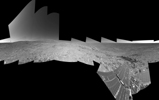 |  |
| Figure 1 | Figure 2 |
NASA's Mars Exploration Rover Spirit takes a good look around at its surroundings high above Gusev Crater as mission planners prepare for solar conjunction on sol 244 (Sept. 9, 2004). On this day, and over the next 11 days, the rover will be out of reach as the Sun moves between Earth and Mars, blocking communications. Scientists are currently discussing potential light-duty assignments that may involve taking images of surrounding terrain, recording wind patterns in the dust, or completing scientific analysis of dust collected on the rover's magnets. Otherwise, Spirit will essentially be on vacation until sol 255 (Sept. 20, 2004).
Dominating the left side of this image, to the east, is the high point of the "West Spur" region of the "Columbia Hills," where Spirit has been exploring rock outcrops since June. On the right side, northwest of the rover's present location, are Spirit's tracks leading up the slope. Dark areas show wheel tracks created when Spirit slipped a bit while negotiating the outcrops. Beyond that, sand dunes on the floor of Gusev Crater can be seen. About one-third of the way across the image from the right is the outcrop dubbed "Longhorn," above the rock dubbed "Clovis," where Spirit used its rock abrasion tool to grind the deepest hole to date on Mars. Just to the left of the middle of this image, a short distance beneath the summit, is a rock outcrop slanting to the left, or north. Spirit will spend the depth of the martian winter there with its solar panels oriented toward the Sun.
Spirit's navigation camera took the images that make up this mosaic from a position labeled Site 86 on sols 228 to 230 (Aug. 23 to Aug. 25, 2004). The three-dimensional, 360-degree view is presented in a cylindrical-perspective projection with geometrical seam correction.
Figure 1 is the left-eye view of a stereo pair and Figure 2 is the right-eye view of a stereo pair.

 Planetary Data System
Planetary Data System














